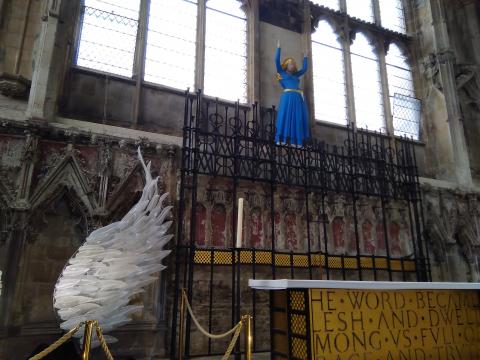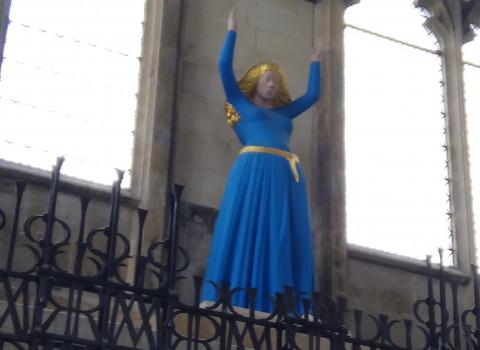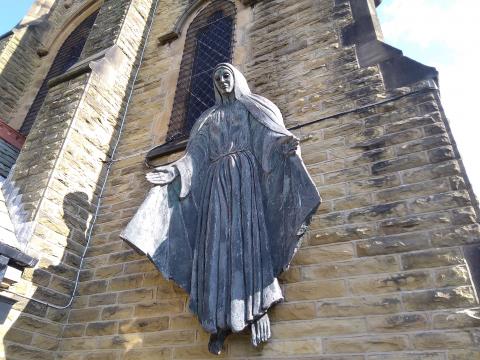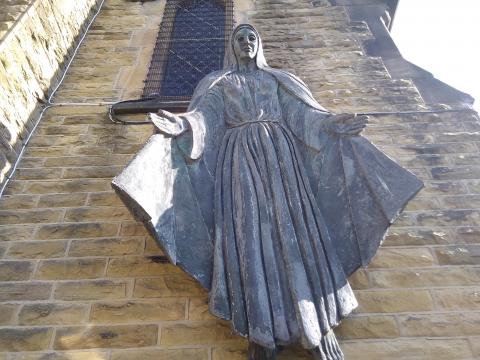Baal's Lady Friend

Ely Cathedral's Lady Chapel, a part of the old building dedicated to Christ’s mother, Mary, struck me as unusually large and impressive. Art historian Paul Bimski says
Ely Cathedral’s Lady Chapel was one of the most splendid artistic and architectural achievements of medieval England. The Catholic chapel’s lavishly painted sculpture and stained glass, devoted to the Virgin Mary, moved pilgrims to a religious frenzy.

Thankfully, the Reformation put paid to this frippery, leaving a rather dignified and graceful compilation of gothic stonework. Like a courtesan after a hot bath, with her makeup removed and sordid odours washed away, the Lady Chapel is a rather pleasant and becoming building, a plain yet elegant place in which to pray and seek God. Yet a rather modern addition has been placed over the altar, straddling a ledge, glaring down- a life-sized doll of a woman with flailing arms, bland expression and bright blue dress. Like some banshee haunting us from the past, Ely Cathedral decided to reinstall a Mary.
Writing in the Guardian, Germaine Greer comments:
The chapel's austere monochrome was harshly assailed in 2000 by the installation of a life-size effigy of a woman with raised arms. Half a ton of Portland stone was hoisted up on to a ledge, from which point the carved female figure dominates and dwarfs the whole space. It stands to reason that a lady chapel needs a lady, and here she is. You can tell she is Our Lady because she wears a full-skirted gown of electric blue. A colour less suited to her surroundings could hardly be imagined, unless it be the staring gilt of the belt slung around her hips and applied to the biggest hair since Dolly Parton. The bodice of the gown is no more substantial than a single coat of blue paint, so the breasts raised by the upraised arms are delineated in a manner more akin to soft porn than religious imagery.
She concludes:
It actually looks more like Genghis Khan in a huge blond wig.
Greer is no Christian, so I suspect the effigy offends her artistic tastes more than any religious sensibility, though her descriptions are more lucid than mine. So for different reasons, I found the doll quite hideous. It is worse than the papist images of old; it looks positively pagan, like Artemis of the Ephesians or Athena of Athens.

At a recent Reading Group, we discussed the rise of Mariolatry in the Early Church. After 500 years of reformation and revivals of Bible preaching, this idolatrous devotion refuses to die. Perhaps there is some psychological reason why churches generally led by men must pay court to a powerful female. Is it a cheap nod to equality, giving place to womanhood in a patriarchal institution? I suspect that this veneration or idolatry is little more than worship of the old Mother goddess, known in Biblical times as Asherah or Ashtoreth. Just as wise Solomon was led astray, so many within the Catholic-based churches continue to lust after her. The clothing might be blue, the facial expression simpering, but this woman is not the Mary of the gospels, the simple and honest handmaiden of the Lord. The harridan immortalised at Ely and Morecambe (above and below), who receives prayers, mediates with God, grants blessings and salvation, is a dim memory of a more ancient and malevolent spirit.

Last two pictures: St Mary's Roman Catholic Church, Morecambe
- Log in to post comments


 Sunday Worship 10.45am & 6.00pm
Sunday Worship 10.45am & 6.00pm